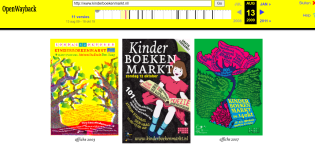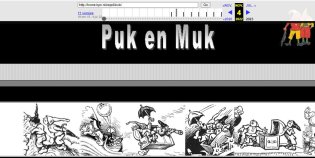The KB has been 'collecting' Dutch websites in its web archive since 2006. Among many other things, this web archive helps preserve the history of Dutch children's books. Many of these websites provide context to the physical collection of children's books, making them important resources for future researchers.
Children's book websites
This certainly applies to the group of some 300 websites that can be categorised as 'children's book websites'. Although archived websites have only brief descriptions and cannot be found in the catalogue, these sites can still be found in this specific subcategory thanks to a specific feature, the UNESCO code.
Many of these websites give context to the hard copy collection of children's books because, for example, they are about a children's book author or illustrator, about an event such as Children's Book Week or were published on the occasion of a specific edition of a book.
Sites belonging to established names such as Paul Biegel, Joke van Leeuwen and Fiep Westendorp have all been included in the archives, alongside the websites of the Kinderjury, Miffy and Dikkie Dik. There are also sites of children's bookshops (such as kiekeboek.nl and lezenisleuk.nl), publishers (Gottmer, Kluitman), comic books (stripjournaal.com, stripmakerdesvaderlands.nl) and websites created by collectors of old children's books and children's literature (hetoudekinderboek.nl, oudejeugdboeken.nl).
A quick glance at the live websites of the above examples paints a striking picture of the diverse ways in which children's books are presented on the internet, ranging from very modern and professional to dated and nostalgic. Some websites target adults, while others were clearly made for children.
Browsing old versions of websites is an even better way to recapture the feeling of the times in which they were created. Websites published a mere 10 years ago already look hopelessly old-fashioned in our eyes, which goes to show how short-lived online style and formatting trends can be. The content is just as fascinating because websites often put news prominently on the homepage, so you get instant insight into which children's books were popular 10 or 15 years ago.
While some popular books and series from back then are still going strong (Dummie de Mummy, Hoe overleef ik [...]), other titles have already been somewhat forgotten (Voor wie doe jij een moord?, door Izzy Love, and Sofie en de pinguïns).
There are also frequent references to websites and organisations that no longer exist; the Dutch social media platform Hyves, for example, was a long-time 'media partner' of the Kinderjury. However, after Hyves went bankrupt in October 2013, its logo disappeared from the Kinderjury's website in the first quarter of 2014 and would later be replaced by the logos of Twitter and Facebook.
The historical thrill of web collections
Finding a web collection that no longer exists gives an even bigger historical thrill. In some cases, websites disappear when the organisations, editors and people behind them discontinued the sites (as in the case of Kinderboekenmarkt.nl), while others went offline because the ISP hosting them went out of business, like XS4ALL, or stopped hosting homepages, like KPN did in 2023.
The KB has managed to harvest many such sites in recent years and although they were only added to the collection fairly recently, many of them paint an excellent picture of the early internet because they have laid dormant for 20 years.
A good example is Puk and Muk, a tribute website to this series of children's books published from 1927 onwards. It is a wonderful example of a website created by an avid collector who shared everything he knew about the subject online, with countless scans of covers, photos and historical documents, and thus reached a larger audience than a local museum or self-published book could ever have done.
The COVID pandemic also spawned multiple children's book sites that were typical of the times and have since disappeared from the live web. Many established publishers lacked the agility to respond to the pandemic, but digitally savvy teachers quickly spotted a gap in the market and started offering their own online teaching packages due to the homeschooling requirement.
They also launched sites with books about the COVID pandemic, including De corona’s op gezinsvakantie and Sem blijft thuis. Later, the larger publishers also followed with books like Het verhaal van Noor en het coronavirus (Uitgeverij Balans). While these publications can no longer be found online, they are still part of the KB’s web collection.
Preserving this born-digital content will prove essential for future researchers who want to understand the 21st century and want to investigate how events such as the COVID pandemic were experienced or covered in children's books. Safeguarding digital content is just as important as preserving hard copy publications, both because of their unique content and because of the historical thrill they can offer.





